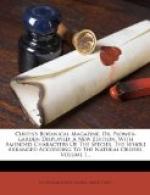SONCHUS tingitanus papaveris folio Raii Suppl. 137.
CHONDRILLA tingitana, floribus luteis papaveris hortensis
folio. Herm.
lugdb. 657. t.
659.
[Illustration: No 142]
I am indebted for seeds of this plant to my very worthy and liberal friend NICH. GWYN, M. D. of Ipswich, to whose penetrating genius, and learned researches, Botany owes much.
As its name implies, it is a native of the province of Tangier, on the Barbary coast; appears to have been cultivated here, according to the Hort. Kew. in 1713, but is not mentioned in the 6th 4to. edit. of MILLER’s Dictionary.
It may be considered as forming a valuable addition to our stock of annuals, being a beautiful plant, and easily cultivated: it thrives best on a moderately dry soil, warmly situated: should be sown in the spring with other annuals.
I have observed, that in the middle of summer, a hot unclouded sun, which is favourable to the expansion of most of the flowers of this class, is too powerful for those of the present plant, which then appear to the greatest advantage in warm hazy weather.
[143]
PELARGONIUM GLUTINOSUM. CLAMMY CRANE’S BILL.
Class and Order.
MONADELPHIA HEPTANDRIA.
Generic Character.
Calyx 5-partitus: lacinia suprema definente
in tubulum capillare
nectariferum fecus
pedunculum decurrentem. Corolla pentapetala,
irregularis. Filamenta
10 inaequalia, quorum 3 raro 5 castrata.
Fructus
pentacoccus, rostratus, rostra spiralia introrsum
barbata.
Specific Character and Synonyms.
PELARGONIUM glutinosum umbellis paucifloris
foliis cordatis
hastato-quinquangulis
viscosis. L’Herit. Ger. Ait.
Hort. Kew. v.
2. p. 426.
GERANIUM glutinosum. Jacq. ic. collect. 1. p. 85.
GERANIUM viscosum. Cavanill. Diss. 4. p. 246. t. 108. f. 2.
[Illustration: No 143]
The leaves of this species exhibit, on being touched, a manifest viscidity, or clamminess, which, independent of their shape, serves to characterize the species; the middle of the leaf is also in general stained with purple, which adds considerably to its beauty; but this must be regarded rather as the mark of a variety, than of the species.
With most of its congeners, it is a native of the Cape, and of modern date in this country, being introduced to the royal garden at Kew, by Messrs. KENNEDY and LEE, in the year 1777.
It flowers from May to September; is readily propagated by cuttings, and sometimes raised from seeds, from whence several varieties have been produced.
[144]
FERRARIA UNDULATA. CURLED FERRARIA.
Class and Order.
GYNANDRIA TRIANDRIA.
Generic Character.




